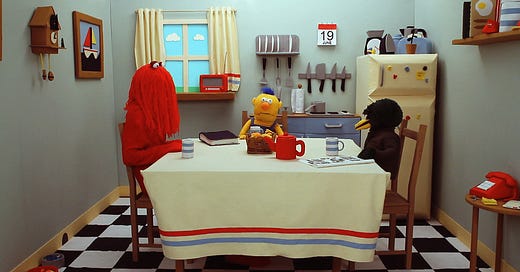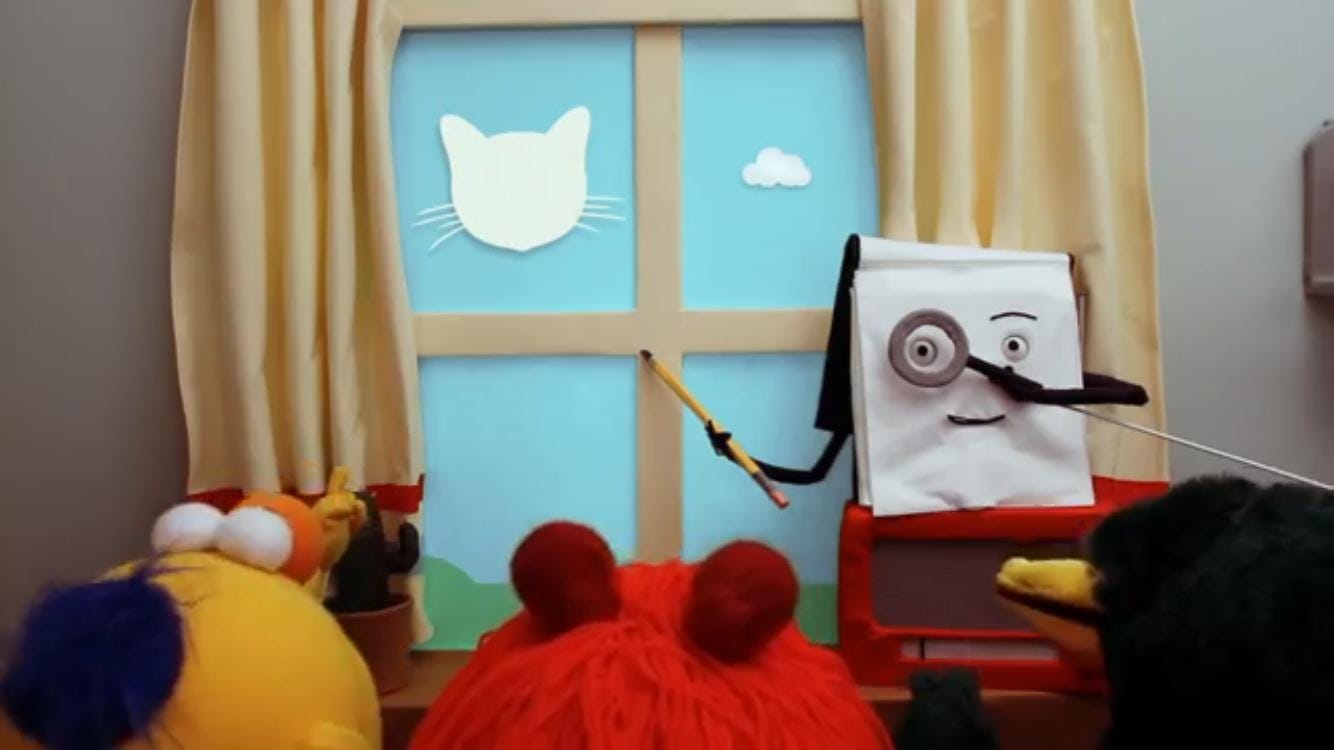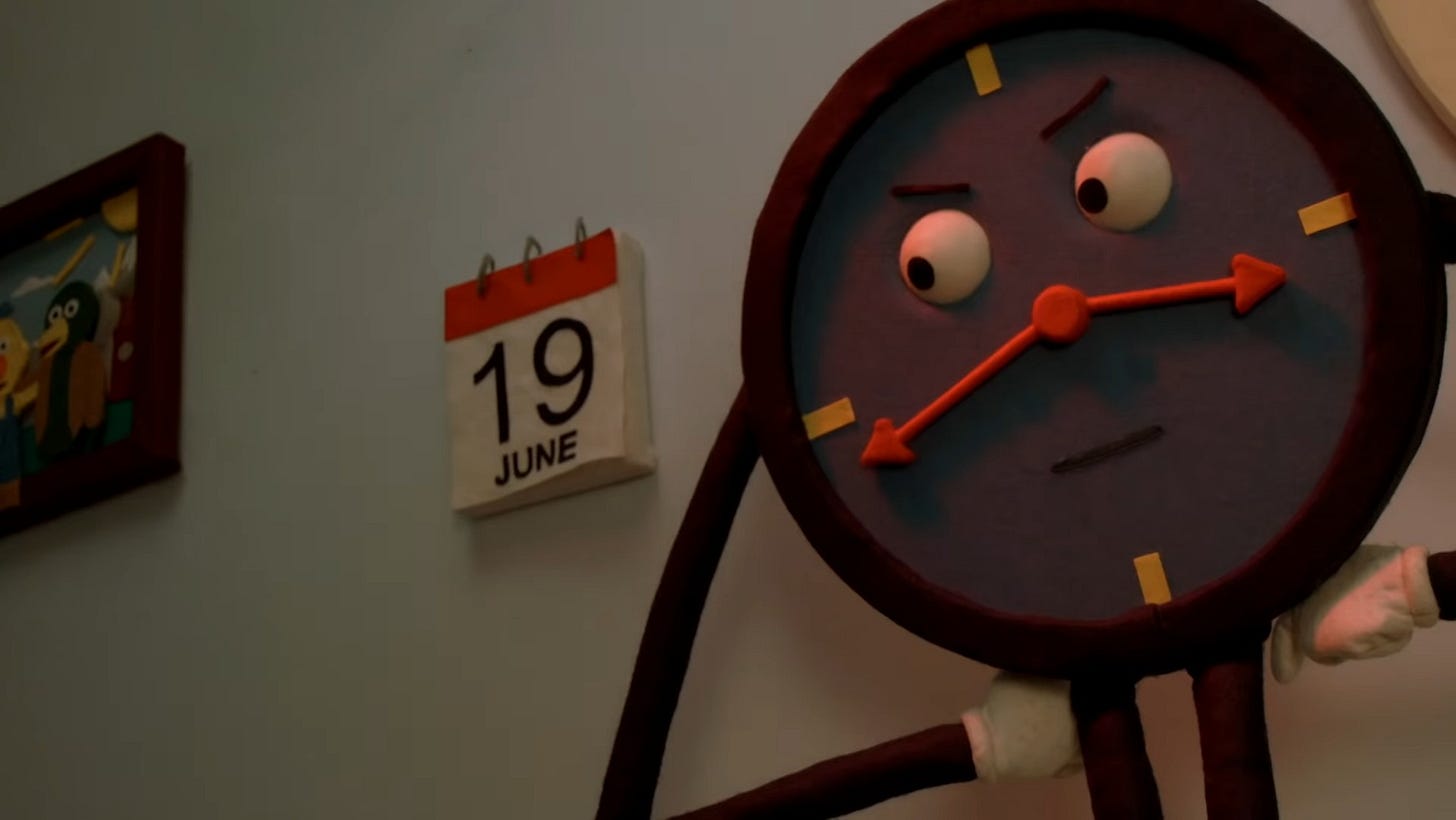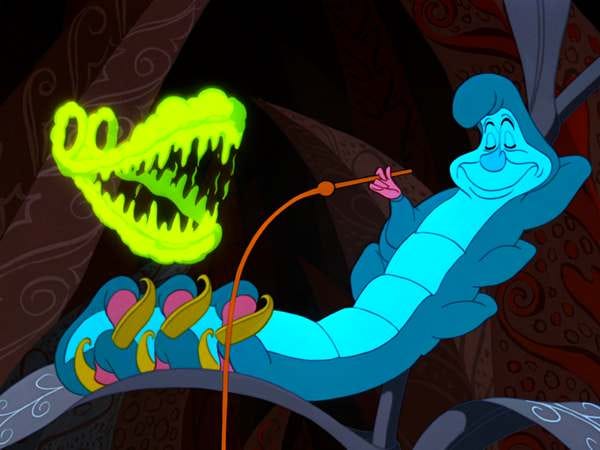Don’t Hug Me, I’m Scared – A Horror Gem
Horror Moments Mini-Series, 'Don't Hug Me I'm Scared' Edition
‘Horror Moments’ is a weekly series examining horror-inflected scenes and themes in unexpected places. The ‘moments’ are published weekly on Thursdays, and I share articles on the history of magic, theatre, storytelling, and more on Mondays. Catch up with the recent Kate Bush series here and the full back catalogue of horror moments (from Wallace & Gromit to Shakespeare) here. Don’t forget to subscribe!
On 29 July 2011, an extremely creepy 3.5 minute video was uploaded to YouTube. It looked, at first glance, like a scene from a children’s programme, everything beautifully crafted from felt, the story told through a mixture of live performance, animation, and puppetry.
It begins harmlessly enough: a notebook comes to life and sings a catchy tune about ‘getting creative’ to a trio of brightly-coloured characters, one yellow, one red, and one green one which looks like a duck.
Our notebook-teacher explains how to use your imagination to invent characters, and how to use your hair to express yourself (she’d make a good Substack guru) — but something isn’t quite right. She’s oddly passive-aggressive, and seems more interested in being listened to than actually fostering her students’ creativity. When one of them wants to use green he is told ‘green is not a creative colour.’ Even more sinister is the fact that a painting she doesn’t like is immediately covered in thick black oil.
“Listen to your heart, listen to your brain, listen to the voices in your brain” she tells them.
They keep making things as the jaunty music starts to warp and distort with Hitchcockian violins slicing through with greater violence. A real (human?) heart is suddenly being covered in glitter at the craft table, the characters are changing size and shape, a slice of cake drips gore as it is lifted from its platter, the world ‘death’ is spelt out in black as something fleshy scuttles into a mousehole—
The it all comes to a halt with an awkward pause.
“Now let’s all agree to never be creative again,” sings the notebook, and then collapses. There ends the video.
‘Don’t Hug Me I’m Scared’ was like nothing the internet of 2011 had ever seen before and the clip went viral. Today, the original video sits at 78 million views.
It struck a chord with the very people who were growing up with YouTube, the generations who had been young children in the 90s or 00s when kids tv was populated with puppets who were forever trying to teach you things in brightly coloured rooms of cartoonishly exaggerated furniture. Many real programmes from the period look trippy to the point of being nightmarish to adult eyes (we’ll return to the Teletubbies later in this mini-series…)
Like all the best parodies, “Don’t Hug Me I’m Scared'“ understood its source material intimately and with enough fondness that each detail had been lovingly made in exactly the right style. Hours of work had clearly gone into the most fleeting of visual jokes, a level of quality that bore repeated viewing and — a crucial aspect of the franchise going forward — speculation about what all those details meant.
After the success of the first, creators Becky Sloan and Joe Pelling kept making short videos to upload online. There were six YouTube shorts in total, all following the same general principle: the same three unnamed characters always meet a ‘teacher’ (usually an anthropomorphic object) and learn a dubious lesson that takes us on a journey from pre-school pastiche to nightmare-fuel. More and more fans asked more and more questions about what linked it all together. Were the characters in purgatory? Were they the hallucinations of a person in a coma? Was there something important about the recurring date of June 19th?
Besides the obvious horror of incomprehensible gory imagery, DHMIS captures the unease that children often feel when adults are behaving in impenetrable or unpredictable ways, when they sense that they’re on the brink of being told off, but aren’t sure why.
It has sometimes been said that the works of Lewis Carroll appealed so successfully to children because he parodied the way that the strict British education system at the time taught everything from manners to philosophy. The way that the teachers in DHMIS demand conformity to rules that make no sense feels just like Alice getting told off by the caterpillar for saying “how doth the busy little bee,” when she should apparently say “how doth the little crocodile,” or being chided for not serving the cake around before she cuts it when she’s journeyed through the looking glass. The arbitrary rage of the Queen of Hearts is only frightening because she has power over Alice, and many children have endured the horror of a grown-up punishing you for a mistake you didn’t know you were making.
In the wake of the viral success of the six shorts on YouTube, the UK Channel 4 commissioned a television series of six half-hour episodes, a much longer run time than the original videos. Everything that had made DHMIS so compelling now had room to breathe and grow and pulsate — and that’s where the fun really began.
We’ll find out more next week in the second of five articles in this mini-series of horror moments, but until then, happy nightmares everyone!
Horror moments are posted every Thursday and a wide variety of articles exploring the history of magic, theatre, storytelling, and more are published on Mondays.








I maintain that DHMIS is some of the most inventive horror ever. One episode in particular really got under my skin.
I think about DHMIS at least once a week. It's so creepy and unsettling in an uncanny way. I always took it as a commentary on how what we say we're teaching children and what we're actually teaching them are really different things - like everyone thinks school is to give children the skills they need to succeed in life, but really it's teaching them how to be good followers and cogs in the machine.
Like how the notebook says they're teaching creativity, but criticizes yellow kid whenever he actually tries something creative.